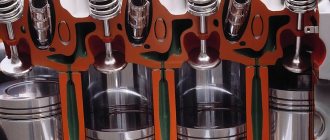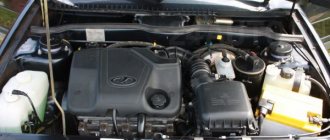What smokes from the VAZ 2110 muffler?
A VAZ 2110 car produces blue smoke from the muffler , visible even at idle.
Having unscrewed the spark plug from the first cylinder I saw a sea of oil! What are these oil scraper rings or caps? Even when starting, this cylinder does not work. There are no extraneous sounds in the engine. Engine with Solex carburetor. And how to configure the distributor yourself. Because the services don’t want to bother.
Hello, please tell me if the engine is 8 valve. I filled the oil with total 5v40, level. I drove about 6000, the level dropped by about 5-7 mm. This is fine? Compression.
There will be no scuffing inside the cylinders of the 2110 engine if I start the engine in the summer and immediately drive (without warming it up at all).
After replacing the cylinder head gasket there is still strong steam. The antifreeze does not leave, the temperature is normal, the stove heats up. What is the reason? The cylinder head was ground, the valves were ground in, the compression was 12 in each.
Blue smoke from the exhaust pipe
The main reason why blue smoke appears from the exhaust is oil getting into the engine cylinders. “Oil” smoke can have different shades - from transparent blue to thick white-blue, which depends on the operating mode of the engine, the degree of its warming up, the amount of oil entering the cylinders, as well as lighting and other factors. It is characteristic that “oil” smoke, unlike steam, does not dissipate quickly in the air, and as a result of the test with paper mentioned in the previous article, oily drops appear, flying out of the pipe along with the exhaust gases.
It is also obvious that “oil” smoke is accompanied by increased oil consumption. Thus, at a consumption of about 0.5 l/100 km, bluish smoke appears mainly in transition modes, and upon reaching 1 l/100 km - also in uniform motion modes. By the way, in the latter case, during transient conditions, the “oil” smoke becomes thick blue-white. However, owners of the most modern cars need to remember about the possible presence of a converter that can clean the exhaust gases from oil even at a fairly high flow rate.
Oil enters the cylinders (more precisely, into the combustion chambers) in two ways - either from below, through the piston rings, or from above, through the gaps between the valve stems and guide bushings.
Wear of parts of the cylinder-piston group is one of the most common causes of “oil” smoke. the upper compression rings experience wear not only along the outer surface in contact with the cylinder, but also along the end planes experiencing gas pressure in the cylinder. The grooves of these rings in the pistons may also be worn out. Large gaps in the grooves create a pumping effect. Even if the oil scraper rings are still normal, oil still enters the cylinders, since the upper rings continuously “pump” it from the bottom up.
Cylinders wear out most of all in the stopping zone of the upper ring when the piston reaches top dead center, and in the middle part they often acquire an oval shape. Deviation of the cylinder shape from the circle impairs the sealing properties of the rings. Gaps usually form in the area of locks, but it is possible that they may appear in other places. therefore, measurements of the cylinder diameter during defect detection are carried out in at least two vertical planes and three to four levels horizontally in order to more accurately determine ovality and ellipse.
It is not uncommon for the cylinder surface to be damaged when the rings and pistons are in relatively normal condition. This happens when the oil filtration is poor, if abrasive particles get between the piston skirt and the cylinder. In the same case, scratches occur on the cylinder.
The same effect often occurs when engine repair technology is violated, if the surface of the repaired cylinder is too rough, or the cylinder is of the wrong shape, or low-quality pistons and piston rings are used. in such cases, as a rule, one cannot count on normal grinding in at all.
Wear of parts of the cylinder-piston group is often accompanied by loss of compression and an increase in crankcase gas pressure, which is determined by appropriate instruments (compressometer, leak tester, etc.). however, it should be remembered that a large amount of oil entering the cylinders well seals the gaps in the mating parts. if they are not too large, then the compression measurement result can be quite normal, sometimes even closer to the upper limit. It is this circumstance that confuses the search for a specific cause of blue “oil” smoke.
By the way, when there is no significant wear on parts, blue or blue-white smoke is clearly visible only when the engine warms up, gradually decreasing and even disappearing. the reason is simple: when heated, the parts take on a shape and take up space in which they fit better together. with excessive wear, the picture is the opposite: smoke on a warm engine will increase, since it is easier for hot oil, which has a low viscosity, to enter the cylinder through worn parts.
It is always easier to identify a malfunction associated with more serious defects or even broken parts. Thus, detonation usually leads to breakage of the bridges between the rings on the pistons, and less often to breakage of the rings themselves. Severe overheating of the engine causes deformation of the piston skirts, creating a large gap between the piston and the cylinder. a deformed piston warps, disrupting the operation of the rings. the same result can occur when the connecting rod is deformed, for example, due to engine hydraulic shock when water enters the cylinder or after a belt breaks and the piston hits a valve that has not closed.
Moisture getting into the cylinders
If white smoke does not disappear even when the engine is running in warm weather, this indicates that coolant is most likely getting into the engine cylinders. This means that when diagnosing, you need to pay attention to the operation of the cooling system. In this case, the color of the smoke may change shade, depending on what exactly is used in the car’s cooling system - antifreeze or antifreeze.
In order to accurately understand whether steam is formed due to water or due to coolant, you can conduct a simple experiment. You need to take a sheet of white thick paper and lean it tightly against the exhaust pipe while the engine is running. If there are no traces of small greasy drops on the sheet, then the reason is water condensation, but if greasy drops appear on the sheet, it means antifreeze or antifreeze is coming out.
Coolant entering the cylinder may be caused by cracks in the block or cylinder head. Another common cause of this phenomenon may be a damaged gasket.
In order to more accurately identify the cause of liquid entering the system, the following series of actions must be performed:
- Remove the expansion tank plug;
- Start the engine;
- Inspect the surface of the tank for oil stains from the liquid.;
- Determine whether the smell of exhaust gases is coming from the tank.
If you notice an oil film on the surface of the expansion tank and smell the exhaust, this means that either a crack has appeared in the center of the cylinder, or the gasket under the cylinder head has worn out.
This is also accompanied by an increase in the liquid level in the tank and an increase in pressure due to gases from the cylinders entering the cooling system. With this problem, after even a short trip you may notice a sharp decrease in the amount of coolant.
As a result of antifreeze or antifreeze leaking from the cooling system and further liquid entering the engine sump, the liquid is mixed with the engine oil. If you insert the dipstick into the crankcase and pull it out, you will see that the oil on it will take on a milky tint.
This oil is not suitable for further use, since its lubricating qualities are lower than those established by technical standards. Therefore, after repairing the engine, it is necessary to carry out a complete oil change.
Why does a car engine smoke?
When starting the engine when cold, thick smoke often appears coming out of the exhaust system. Smoke can have different shades from white to blue and even black. The smoking stops after the engine warms up, and may continue afterwards.
If a warm engine smokes, this means that the power unit has specific malfunctions. The color of the exhaust gases indicates the stage of development of the breakdown and its severity.
Why does the engine smoke: symptoms
In some cases, smoke may be accompanied by the following symptoms:
- difficulty starting a cold engine;
- unstable operation of the engine both at idle and under load;
- inconsistency of tachometer readings (speeds fluctuate);
- increased fuel and engine oil consumption;
- loss of power of the power unit.
There are often situations in which engine smoking is the only warning sign.
The design of the vehicle is designed for the system to constantly, unnoticeably release exhaust gases into the atmosphere in specified volumes. But if, when starting the engine, smoke comes out of the exhaust pipe in large quantities, it is necessary to urgently look for the cause of the alarming symptom that has appeared.
The first thing you need to pay attention to is the color, shades and density of the smoke coming from the engine. The most common colors of the gases released are:
Each of the listed smoke colors can have different shades, but this division into groups is the main one.
To preserve engine life...
Be that as it may, you should clearly know that black exhaust is dangerous not because it spoils the environment (soot flies out of the muffler and smells of gasoline), but also disrupts the normal operation of the engine, leads to increased fuel consumption and reduces the efficiency of its operation. You should always remember that particles of coked fuel not only fly out of the muffler, but also enter the piston group, becoming an abrasive and rapidly wearing out the polished (ideally, like a mirror) working surface of the liners, pistons and sealing rings.
This can lead to a noticeable drop in the service life of the engine, and instead of the required, say, according to the passport data, 500 thousand kilometers (modern cars are designed for approximately this service life) before repair, the engine will work an order of magnitude less. This is why black exhaust from an engine muffler is dangerous in the first place. » alt=»»>
Clear smoke from the exhaust pipe
The steam coming out of the engine can be mistaken for white smoke. Steam is formed during the evaporation of accumulated liquid in cooled engine systems. Most often, the accumulation of liquid at the end of the exhaust pipe and the release of steam are observed in the cold season after starting the engine.
The engine and exhaust system components heat up and water evaporates rapidly. After the engine and exhaust system have completely warmed up, the amount of steam is reduced to a minimum or disappears completely.
The amount of steam released depends on the humidity levels in the environment; the higher they are, the longer its traces will be visible. The release of steam is not a sign of breakdown of engine parts and components; if this effect occurs, repairs are not required.
When is it too early to worry?
Oil smoke doesn't always push you in the direction of the auto repair shop. You can take a closer look, listen and draw appropriate conclusions, but do not rush into an accurate diagnosis in 2 cases:
- a new (or almost new) car (read how to break it in correctly);
- car after a long period of inactivity.
In these cases, the engine smokes oil simply because its individual parts have not gotten used to each other. A sign of such a situation can be a gradual cessation of smoking as the engine warms up. You need to observe the development of events for 2-3 days. If at this time the oil smoke gradually becomes clearer and the time it dissipates is reduced, it means that the grinding is going well and there are no problems in your engine yet.
Black smoke coming out
The greatest damage to the environment is caused by clouds of black smoke coming out of a car's exhaust pipe or directly from the power unit. The most likely reasons for the appearance of such smoke lie in the following violations:
- malfunctions of the engine control system;
- disorder of adjustments in fuel equipment;
- reducing engine cylinder compression.
An imbalance between the number of components of the air-fuel mixture in the direction of increasing fuel causes not only the formation of black smoke, but also significantly increases fuel consumption. Failure of the normal mixture formation process may be caused by contamination of the air filter. A deficiency of air entails an excess of fuel when preparing the air-fuel mixture.
A decrease in the compression level can be caused by mechanical damage to the cylinders, which significantly reduces the power of the power unit and contributes to an increase in the concentration of fuel in the mixture.
To carry out accelerated diagnostics, it is necessary to examine the condition of the spark plugs. Black deposits indicate that there is a need to replace spark plugs with new samples, followed by repair of deformed elements and regulation of power unit systems.
White smoke appears
An engine that smokes white gas does not always release harmless water vapor. White smoke is distinguished from steam by the following characteristics:
- increased smoke density;
- long-term dispersion;
- presence of a persistent burning odor;
- does not disappear when the engine warms up.
White thick smoke coming from the exhaust pipe of a car indicates a malfunction in the cooling system. The variety of shades of white smoke depends on the type of coolant used, but in any case, with such emissions, it is necessary to carry out urgent repairs to the engine cooling system.
Incorrect operation of the cooling system elements can lead to serious disruptions in the functioning of the power unit as a whole.
Causes of white smoke:
- cracks in the cylinder head (cylinder head);
- coolant entering the engine cylinder cavity;
- motor overheating;
- use of low quality coolant.
If the cylinder head seal is broken, the coolant penetrates into the cylinders and into the engine sump crankcase. When lubricants are diluted with antifreeze or antifreeze, the viscosity of the oil decreases, which significantly affects its functions.
How to fix a fluid leak
Remove the cylinder head and block, inspect the gasket: most often the matter ends with replacing the consumables. Next, check the block for leaks: look for leaks near the valve seats, examine the cylinders one by one. If a leak is found, replace the defective parts.
However, the working fluid enters the cylinders in a different way - through the fuel intake system. It is difficult to detect the problem: there is no burning smell, the pressure is normal, but the lubricant turns into an emulsion, and the liquid level drops. There is no need to dismantle the cylinder head: inspect the intake manifold, find the place where the coolant leaks into the “pants”.
Troubleshooting white dense smoke
When disassembling the cylinders, it is necessary to analyze the condition of the spark plugs. The formation of scale on the candles indicates that water has gotten inside. After examining all cylinders and glow plugs located in them, it is necessary to repair or replace the cylinders and glow plugs. It is recommended that these measures be carried out with the help of qualified technicians at the nearest service station.
Often, low-quality coolants, when in contact with the working elements of the engine, cause increased corrosion of components and parts of the power unit. Cheap varieties of antifreeze can literally corrode the internal parts of the engine when leaks occur. After such an impact, it is not possible to repair damaged parts.
To ensure that the coolant penetrates into the combustion chamber, it is necessary to remove the cap from the expansion tank. A sharp burning smell, a decrease in the level of antifreeze in the tank, and a floating oil film indicate the detection of this defect.
Description of the reasons for the appearance of white smoke with a blue tint
Why does the engine smoke white gas with a bluish or blue tint? When researching the origin of gray or blue exhaust, the following reasons are most often cited:
- Damage to valve stem seals.
- The occurrence of rings designed to remove residual oil from the cylinder walls.
- Turbocharger malfunction.
- The oil used is of low quality.
The purpose of the caps is to hold the oil before it is supplied. Poor quality and malfunction of these elements lead to loss of tightness; lubricant constantly leaks and accumulates in the cylinders. As soon as you start a cold engine after a long break, the accumulated oil will burn together with the fuel in the chamber, blue or dark blue smoke will burst out of the car’s exhaust pipe in a huge cloud.
Wear and sticking of oil scraper rings leads to excess lubricant entering the engine cylinders and subsequent combustion. The use of the ring decarbonization method temporarily solves the problem, but in this case the rings lose their elasticity, and the occurrence may resume. To avoid serious damage to the power unit, it is necessary to constantly monitor the color of the exhaust gases.
With little wear of engine elements, a short-term release of blue smoke is observed during cold operation. As the motor heats up, the parts expand as a result of an increase in their temperature, which has a beneficial effect on the gaps between the mating surfaces of the elements. The smoke output decreases or disappears altogether.
Black smoke for different engine types
Black smoke from the exhaust pipe may be a result of an over-rich mixture in the combustion chamber. The reason for this is a malfunction in the fuel system. Different types of motor will have their own reasons for the effect.
Black smoke from the gasoline exhaust pipe (carburetor)
Carburetor engines are notorious for their smoke. The cause of the malfunction is a forgotten air filter or uneven fuel supply. Often the reason lies in the carburetor and its settings. In order for a malfunction to occur, it is necessary to “sort out” the fuel supply element and also configure it correctly. It is recommended to contact specialists in this field who have been adjusting carburetors of various types for decades.
Another reason could be the spark plugs. A broken spark plug or incorrect gaps will result in black smoke coming from the exhaust pipe.
Black smoke from the gasoline exhaust pipe (injector)
For gasoline injection engines, the reasons are the same as for carburetors, only instead of carburetor malfunctions, the injectors fail. Uneven fuel supply or a rich mixture causes black smoke to appear from the exhaust pipe.
Black smoke from diesel exhaust pipe
A diesel engine smokes as a result of incomplete combustion of fuel in the combustion chambers. As with a gasoline engine, the cause is an incorrect air-to-fuel ratio. Also, the cause may be a worn gas distribution mechanism.
Abrasive processes in the combustion chamber: what threatens black exhaust
Black exhaust always indicates increased fuel consumption when the engine is running, but this is a consumption that does not affect the increase in power. On the contrary, there is a drop in power, and a significant one. And now - the most important thing.
- The fact that black smoke is pouring out of the muffler is not the worst thing.
- The fact that this black exhaust is accompanied by a drop in power (at which the car in fourth gear develops at most 100 - 120 kilometers per hour) is also not the worst thing.
- Even the fact that gasoline consumption doubles is not the worst consequence.
Black exhaust from the muffler threatens serious problems for the engine due to the fact that carbon particles fly out not only from the muffler.
They enter the combustion chamber and, without burning, remaining there, in the space in which the pistons “walk”, stick to the walls of the piston liners, acting as a kind of abrasive, undermining the walls, which in theory should be perfectly smooth and polished . This is what the notorious black exhaust is. It is capable of reducing the service life of the engine by an order of magnitude, several times, causing a complete repair (with grinding or replacement of liners).
Unburned excess fuel can also enter the lubrication system, diluting the oil, making it unsuitable for lubrication. Sometimes this process is so intense that the oil level in the crankcase increases noticeably. Which, of course, also does not contribute to the long-term operation of the engine. As well as the fact that gasoline that gets on the walls of the pistons and cylinders simply washes away the lubricant. As a result of all this, small scratches, and maybe even serious scuffs, may form on the walls, which in no way contribute to the normal operation of the engine.
Turbocharger and causes of bluish smoke
If the car is equipped with a turbocharger, then the output of thick bluish smoke may be due to its unsatisfactory condition. As a result of a malfunction of this unit, engine oil designed to lubricate the turbine bearings leaks. The lubricant penetrates the engine starting system.
During the combustion of turbocharger oil, thick bluish smoke is formed, causing irreparable harm to the atmosphere.
To diagnose the turbine, you must perform the following steps:
- Disconnect the turbine from the engine.
- Check for oil accumulation inside the air duct.
The accumulation of large amounts of oil in the air duct and turbine is a serious defect. If you discover such a situation, you must immediately seek qualified assistance from a service center.
The influence of the quality of the oil used on smoke formation
Motor oil must have certain characteristics. The quality of the lubricant used directly depends on its properties. If the car engine contains low-quality oil, the viscosity coefficient of which does not correspond to the car brand, or if the temperature inside the engine increases, a sharp loss of useful properties of the lubricant occurs, this leads to serious damage to the elements and systems of the power unit. If blue smoke appears, you need to check the oil for compliance and, if necessary, completely replace it.
The appearance of smoke can be caused by a number of other reasons - from the appearance of microcracks in the engine body to the use of the wrong type of fuel intended for a given engine brand. Each specific situation always has a solution when seeking help from qualified specialists.











